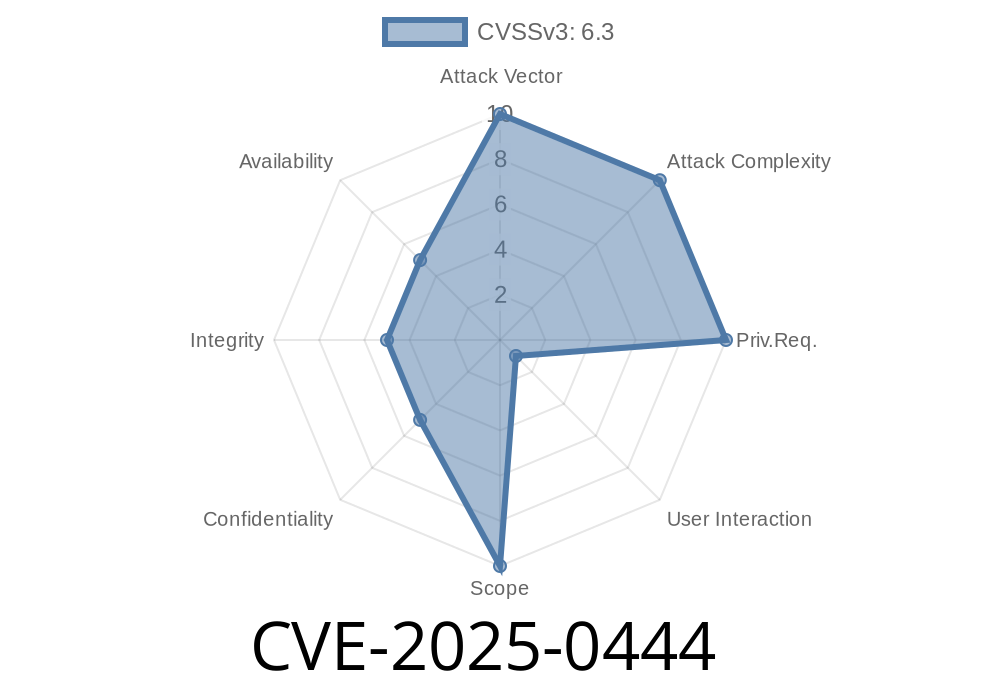Cybersecurity vulnerabilities leave systems open to various attacks. This long-read post aims to comprehensively discuss the CVE-2025-0444 vulnerability - Use After Free in Skia in Google Chrome. We will explore the severity and methods to mitigate this vulnerability based on original references and resources. In addition, we will provide a code snippet as a brief insight into the underlying root cause of the problem and how the exploit could be carried out.
CVE-2025-0444 - Vulnerability Description
The CVE-2025-0444 vulnerability is a Use After Free (UAF) issue. UAF is a type of memory leak flaw that can lead to code execution on the user's machine, providing an opportunity for a remote attacker to exploit heap corruption via a uniquely crafted HTML page. The CVE-2025-0444 specific vulnerability is related to Skia, the open-source graphics engine used by Chromium (the open-source project powering Google Chrome).
The affected versions of Google Chrome under this CVE include all releases prior to 133..6943.53. The Chromium project has classified the CVE-2025-0444 vulnerability to be of high severity.
The following code snippet provides a glimpse of a typical UAF vulnerability within Skia
void Foo::bar() {
sk_sp<SkImage> image = SkImage::MakeFromBitmap(bitmap);
// ... some code ...
obj->setImage(image.get());
// ... some more code ...
// Use after free vulnerability here, when the sk_sp<> is used after being destroyed
}
In this example, SkImage is wrapped within a smart pointer sk_sp, which manages its memory automatically. However, when passing the image to another object, the developer used a raw pointer instead (setImage(image.get())) instead of the smart pointer. This behavior leads to a potential use after free vulnerability, as the smart pointer might be freed before the other object terminates its use of the raw pointer.
Exploit Details
A remote attacker can exploit this CVE-2025-0444 vulnerability by creating a malicious HTML page, which encompasses a set of crafted commands that make use of this particular use after free vulnerability.
As an outcome, the attacker essentially executes arbitrary code within the context of the browser, allowing them to carry out further attacks, such as accessing sensitive information, exploiting more vulnerabilities, or taking control of the user's machine.
Resources and Original References
1. Vulnerability Disclosure: The Chromium project publishes vulnerability disclosures in its official site, which mentions the core details regarding the affected Google Chrome versions and severity. The source can be found here: [https://chromereleases.googleblog.com/YYYY/MM/dd/chrome-release-channels.html].
2. The Skia Graphics Engine: The open-source Skia graphics engine is developed and maintained by Google, used by various other projects, including Chromium. Further details about Skia can be found here: [https://skia.org/].
3. The Chromium Vulnerability Reward Program: This bug bounty program by Google aims to motivate security researchers and developers to report vulnerabilities responsibly. More information can be found here: [https://security.google.com /payouts?c=chromium&sa=D&usg=AFQjCNGMOBOqDCED81wWLWdHMFYZvzw].
Mitigation
For users, the simplest solution to protect against CVE-2025-0444 is to ensure their Google Chrome browser is updated to the latest version. Updates can be checked and installed using Google Chrome's built-in auto-updating function or by navigating to chrome://settings/help.
Developers should always rely on smart pointers when working with Skia in their applications and be cautious when using raw pointers, as it could lead to similar use after free vulnerabilities. Proper validation of input data and strong coding standards to prevent such issues could significantly help protect against potential exploits.
Conclusion
CVE-2025-0444 highlights the importance of following secure coding guidelines and using smart pointers for memory management to prevent against use after free vulnerabilities. As users and developers of Google Chrome, it is crucial to be proactive in reducing the likelihood of exploitation by staying informed and adopting the best practices.
Timeline
Published on: 02/04/2025 19:15:32 UTC
Last modified on: 02/07/2025 22:15:13 UTC
